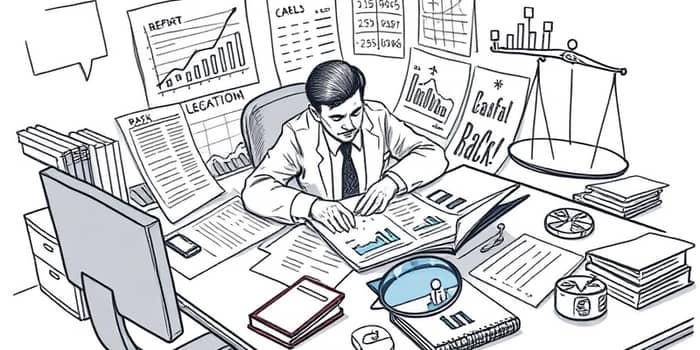In today’s competitive financial landscape, securing the right investment demands more than intuition or surface-level analysis. Investors must peel back every layer of an opportunity to confirm its true potential.
By diving deep into every facet of an asset, from legal standing to market positioning, decision-makers can negotiate stronger terms and avoid unforeseen pitfalls that erode value later.
Definition and Purpose of Due Diligence
Due diligence is the systematic research and analysis performed by an investor before committing funds to an asset or transaction. At its core, it is a thorough investigation process investors undertake to confirm facts, evaluate risks, and understand potential rewards. This process mitigates the principle of “caveat emptor,” or buyer beware, by ensuring that investors are fully informed before finalizing decisions.
Serving as a safeguard against unforeseen risks and uncertainties, due diligence validates financial data, legal positions, and market assumptions. It empowers decision-makers to negotiate informed terms, avoid costly surprises, and align documentation with strategic objectives.
Why Due Diligence Is Critical in Investment Selection
Investors who forgo thorough review expose themselves to hidden liabilities, manipulated records, or flawed business models. Conducting due diligence can reduce the risk of financial loss by uncovering performance inconsistencies, unresolved claims, or regulatory non-compliance. Armed with verified information, investors gain confidence and negotiating power when structuring deals.
Furthermore, due diligence is not a one-off event but a continuous discipline aligned with evolving markets. Revisiting your initial investment thesis as conditions shift helps maintain alignment with objectives and prevents unwelcome surprises long after the transaction closes.
Key Types of Due Diligence
Each category of due diligence addresses a distinct dimension of risk and opportunity:
Commercial due diligence evaluates the target’s market positioning, competitive landscape, customer segmentation, and growth forecasts. It answers questions about demand stability and revenue drivers.
Legal due diligence involves reviewing corporate governance, contract obligations, intellectual property ownership, pending litigation, and regulatory compliance. This step secures title to assets and highlights potential claims.
Financial due diligence validates historical financial statements, audits revenue recognition, assesses debt schedules, and verifies tax compliance. It ensures that projections align with realistic performance drivers.
Operational due diligence examines organizational structure, management capabilities, governance policies, supply-chain integrity, and IT systems. It often focuses on scalability and efficiency.
A balanced approach includes both quantitative metrics and qualitative factors such as culture. According to a CAIA survey, 96% of investment professionals value leadership quality and corporate culture equally or more than raw numbers in certain asset classes.
The Due Diligence Process: Step-by-Step
Before any transaction, investors should begin with broad research and goal-setting. Initial steps typically include gathering financial statements, tax returns, and business plans; conducting market analysis to assess trends, competitor moves, and macroeconomic headwinds; and interviewing key stakeholders to verify relationships and uncover hidden risks.
Next comes a detailed evaluation phase, which covers financial analysis—auditing income statements, verifying debt schedules, and stress-testing projections—legal review to confirm asset ownership and contract enforceability, and operational checks that inspect HR policies, governance protocols, and physical asset conditions. Industry research taps independent reports on sector health, while sustainability and ESG assessments ensure environmental practices and compliance align with stakeholder expectations.
Common Pitfalls and Red Flags Identified Through Due Diligence
- Inaccurate or manipulated financial records.
- Outstanding litigation or unresolved legal claims.
- Unstable management teams or governance weaknesses.
- Overly optimistic growth projections.
- Dependency on a few key customers or suppliers.
- Regulatory non-compliance or potential sanctions.
- Unverified environmental or sustainability practices.
Numbers and Research
Reliable statistics reinforce the tangible value of due diligence. A leading CAIA survey revealed that 96% of investors rate qualitative insights as equally or more critical than quantitative data for certain investments. Industry analyses show that robust due diligence can reduce post-transaction surprises by up to 70%, substantially increasing the likelihood of achieving targeted returns.
While exact success rates vary by sector, best practice guides consistently report that disciplined due diligence correlates with better alignment to strategic goals, improved integration outcomes, and lower long-term costs associated with dispute resolution or remediation.
Due Diligence Checklist Components
- Financial statements: audited reports, tax filings, budgets, and forecasts.
- Legal documents: corporate charters, licenses, contracts, and IP agreements.
- Market research files: industry analyses, competitor benchmarks, and SWOT frameworks.
- Stakeholder information: management bios, board composition, and key customer/supplier agreements.
- ESG and sustainability data: compliance certificates, environmental audits, and social impact reports.
Conclusion
Due diligence remains the cornerstone of sound investment selection, creating a foundation of trust and clarity. By thoroughly evaluating commercial viability, legal standing, financial strength, and operational resilience, investors protect their capital and optimize upside potential.
Combining both quantitative analysis and qualitative insights ensures a holistic view of risk and opportunity. Structured processes, comprehensive checklists, and continual reassessment empower investors to navigate complexity and secure lasting success. In every stage—from initial research to post-close monitoring—due diligence is not optional but essential for informed, confident decision-making.
As markets evolve and new technologies disrupt traditional sectors, only those who commit to ongoing vigilance and rigorous scrutiny will consistently outperform and achieve long-term objectives.
References
- https://www.neotas.com/investment-due-diligence-checklist/
- https://www.manifest.ly/use-cases/financial-services/investment-due-diligence-checklist
- https://www.assetmark.com/blog/due-diligence-for-financial-advisors
- https://dealroom.net/faq/due-diligence-process
- https://www.fynsa.com/en/newsletter/los-distintos-enfoques-de-due-diligence-cualitativo-y-cuantitativo/
- https://www.4degrees.ai/blog/how-to-conduct-private-equity-due-diligence
- https://www.cfainstitute.org/insights/professional-learning/refresher-readings/2025/investment-manager-selection
- https://www.duanemorris.com/articles/due_diligence_fund_finance_transactions_0124.html










